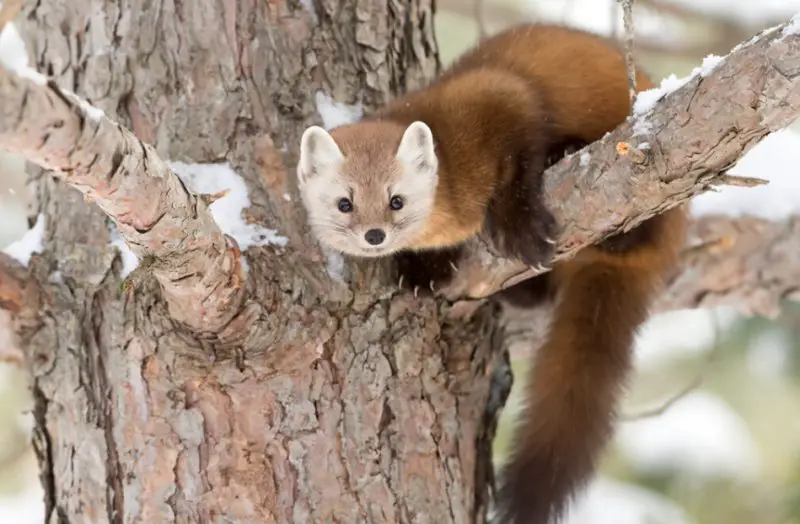The forests of Idaho are home to some of the most secretive and fascinating wildlife in North America. Among the hidden gems is the American marten, a small but agile predator that thrives in the state’s dense wilderness. Known for its elusive nature and graceful movements, this carnivorous mammal is both admired by biologists and rarely seen by the casual observer. For wildlife enthusiasts and nature travelers, discovering the American marten in Idaho forests offers an unforgettable glimpse into the complexity of the ecosystem.
Despite its small size, the American marten plays a crucial role in Idaho’s forest ecology. It regulates prey populations, disperses seeds indirectly through predation, and serves as an indicator species for healthy forest habitats. Yet, because it is nocturnal and stealthy, few people ever have the chance to witness it in the wild. This rarity makes encounters with the American marten especially thrilling.
In this article, we will explore everything you need to know about the American marten in Idaho—from its physical characteristics and behavior to its diet, habitat preferences, and best places to observe it. We will also uncover fascinating facts and explain why conservation efforts are essential for this elusive mammal.
Physical Characteristics of the American Marten

The American marten is a member of the weasel family (Mustelidae), sharing kinship with fishers, otters, and minks. Its body is slender and elongated, which allows it to maneuver through dense underbrush and snow-covered terrain with ease. Adults typically measure between 18 and 25 inches long, including a bushy tail that makes up about one-third of their total length. Weight ranges from 1.5 to 3 pounds, with males being slightly larger than females.
One of the most striking features of the American marten is its fur. The coat is usually a warm brown, ranging from pale yellowish tones to darker chestnut shades, with a distinctive orange or cream-colored throat patch. This coloration provides excellent camouflage in Idaho’s forests, especially during autumn when foliage mirrors the animal’s hues. In winter, their fur thickens, offering insulation against harsh cold.
The marten’s face is narrow with sharp, rounded ears and bright, alert eyes. These adaptations, combined with semi-retractable claws, make it both an adept climber and a formidable hunter. Its lightweight frame and agility allow it to pursue prey even in treetops, setting it apart from other forest carnivores.
How to Identify the American Marten in the Wild
Spotting an American marten in Idaho is a challenge, but certain identifying features can help distinguish it from other small mammals. Unlike fishers, which are larger and darker, martens are smaller and more colorful, with their signature throat patch being the key giveaway.
Their long, bushy tail often appears proportionally larger compared to their body, providing balance while navigating snowy landscapes and branches. Tracks in the snow also provide clues: marten prints show four toes on the front paws and five on the hind, usually appearing in a bounding pattern that suggests quick, leaping movements.
Observers should also pay attention to behavior. Martens are more arboreal than many mustelids, often climbing trees in pursuit of squirrels or birds. If you catch sight of a small, cat-like silhouette darting gracefully between trunks or across the forest floor, there’s a good chance you’ve spotted this elusive carnivore.
Size and Sexual Dimorphism
American martens display moderate sexual dimorphism, with males significantly larger than females. Male martens can reach up to 25 inches in length and weigh close to 3 pounds, while females often remain closer to 18–21 inches and weigh just under 2 pounds. This difference influences their roles in hunting and territorial range.
In terms of territory, males require larger home ranges, sometimes exceeding 5 square miles, while females occupy smaller, overlapping areas. The larger size of males also gives them an advantage when preying on slightly bigger animals, such as hares or squirrels, whereas females may focus more on smaller rodents.
This size variation plays an important role in reducing competition between sexes. By dividing prey sources and hunting territories, martens maximize survival within Idaho’s challenging forest ecosystems.
Behavior and Daily Activity
The American marten is primarily nocturnal, though it may also show activity during dawn and dusk. Its secretive behavior contributes to its reputation as an elusive species in Idaho. Unlike some carnivores that rely heavily on strength, martens depend on agility, speed, and intelligence.
They are solitary animals, coming together only during the breeding season in summer. Outside of that period, martens defend their territories aggressively, marking them with scent glands. Males tend to patrol wider areas, while females remain closer to denning sites, especially when raising young.
In winter, martens often tunnel under the snow to hunt or travel unseen. This adaptation allows them to avoid predators such as owls, hawks, or coyotes. Their playful nature is also well-documented; researchers have observed martens engaging in snow-sliding and climbing for what seems to be pure enjoyment.
Diet and Hunting Strategies
The American marten is an opportunistic carnivore with a diet that reflects the seasonal availability of prey in Idaho. Small mammals form the bulk of its diet, especially red squirrels, voles, and mice. These rodents provide a consistent food source in the coniferous forests where martens thrive.
During summer, martens diversify their diet by hunting birds, insects, and amphibians. They are skilled tree climbers and can snatch fledglings or raid nests. In addition, martens occasionally eat fruits and berries, particularly when animal prey is scarce. This flexibility helps them survive through fluctuating seasons.
Martens are ambush hunters, using stealth and surprise rather than sheer power. Their lightweight bodies and sharp claws allow them to pursue prey through trees, while their keen senses of smell and hearing help locate hidden rodents beneath snow. Unlike larger predators, martens rely on persistence and agility, making them one of Idaho’s most skillful small hunters.
Habitat of the American Marten in Idaho
Idaho provides some of the best habitat for American martens in the western United States. They prefer mature, conifer-dominated forests with dense canopies and plenty of fallen logs for cover. Lodgepole pine, spruce, and fir forests in the northern and central mountains are prime environments.
Martens avoid open landscapes, grasslands, or heavily logged areas where cover is minimal. They rely heavily on old-growth forests because these habitats provide abundant prey and safe denning sites in tree cavities or root systems. Snow cover is another crucial factor, as it allows martens to hunt effectively during winter.
In Idaho, martens are most commonly found in wilderness areas such as the Clearwater National Forest, Payette National Forest, and parts of the Sawtooth Range. Their presence is a positive indicator of forest health, as they are sensitive to habitat disruption.
Reproduction and Life Cycle
Breeding season for American martens in Idaho occurs during summer, typically July through August. Males and females interact briefly for mating, after which the female raises the young alone. Interestingly, martens exhibit delayed implantation—fertilized eggs do not begin developing until late winter, ensuring that kits are born in spring when food is plentiful.
A female usually gives birth to 2–4 kits in a den lined with moss, grass, or feathers. Kits are born blind and helpless, depending entirely on the mother for survival. By summer, they begin learning to hunt and climb, gradually gaining independence.
Life expectancy in the wild averages 6–10 years, though predation and environmental pressures can shorten this span. Despite being relatively small carnivores, martens face dangers from larger predators like raptors, coyotes, and bobcats.
Fun Facts About the American Marten
One fascinating fact about the American marten is that it can rotate its hind legs nearly 180 degrees, allowing it to climb down trees headfirst like a squirrel. This adaptation makes it exceptionally agile in the forest canopy.
Martens are also known to store surplus food during times of abundance. They often cache prey in tree hollows or under snow, ensuring they have resources during leaner months. This behavior showcases their intelligence and survival instincts.
Another intriguing trait is their playful personality. Much like otters, martens have been observed sliding down snowbanks or wrestling with each other outside of breeding season. Such behaviors highlight that survival in Idaho’s forests doesn’t exclude moments of pure joy.
Best Places to Observe the American Marten in Idaho
For those hoping to catch a glimpse of the American marten in Idaho, patience and timing are key. Remote, high-elevation forests provide the best opportunities. Winter tracking is often the most successful method, as fresh snow preserves prints and reveals active territories.
Popular observation sites include the Clearwater and Nez Perce-Clearwater National Forests, the Selkirk Mountains near the Canadian border, and parts of the Sawtooth Wilderness. Backcountry trails that wind through old-growth conifers provide the highest likelihood of sightings.
Wildlife enthusiasts should look for signs rather than expect a direct encounter. Tracks, scat, and claw marks on trees are more common indicators of a marten’s presence. Those lucky enough to spot one will remember the encounter as a highlight of Idaho’s wild beauty.
Conservation Status in Idaho
While American martens are not currently endangered, their populations are vulnerable to habitat loss. Logging and forest fragmentation reduce suitable habitats, limiting prey availability and denning sites. In Idaho, conservation efforts focus on preserving old-growth forests and maintaining large, connected wilderness areas.
Martens also serve as an important bioindicator species. Their presence signals a healthy, functioning ecosystem, while their absence may indicate ecological stress. By protecting the American marten, Idaho simultaneously protects a wide range of other wildlife that shares the same habitat.
State wildlife agencies and researchers continue to monitor populations through tracking surveys and habitat studies. Conservation-minded hikers and outdoor enthusiasts can also contribute by reporting sightings and supporting forest preservation initiatives.
Conclusion
The American marten in Idaho forests represents the perfect blend of mystery and ecological significance. With its agile body, secretive habits, and vital role in maintaining forest balance, this small carnivore captivates anyone who learns about it. Though difficult to observe, its presence enriches Idaho’s wilderness and reflects the health of the ecosystem as a whole.
For those who venture into the dense forests of Idaho, discovering the American marten is both a challenge and a reward. Whether you find its tracks in the snow, hear its rustle in the underbrush, or—if lucky—see its curious eyes peeking from a tree, the experience connects you to the untamed beauty of the wild. Protecting these forests ensures that the American marten continues to thrive for generations, remaining one of Idaho’s most elusive and enchanting inhabitants.
FAQs About the American Marten in Idaho
What is an American marten?
The American marten is a small carnivorous mammal in the weasel family. It is known for its slender body, bushy tail, and distinctive orange throat patch. In Idaho, it inhabits dense coniferous forests and plays an important role in maintaining ecological balance.
Where can I see the American marten in Idaho?
The best places to observe the American marten in Idaho include the Clearwater National Forest, Nez Perce-Clearwater National Forests, the Selkirk Mountains, and the Sawtooth Wilderness. Martens are elusive, so spotting them requires patience, winter tracking, or sheer luck.
How big does an American marten get?
Adult American martens typically measure between 18 and 25 inches in length, including the tail. They weigh between 1.5 and 3 pounds, with males generally larger than females.
What do American martens eat in Idaho?
Their diet mainly consists of small mammals like squirrels, voles, and mice. They also eat birds, insects, amphibians, and even berries when animal prey is scarce. This adaptability helps them thrive in Idaho’s forests year-round.
Are American martens dangerous to humans?
No, American martens are not dangerous to humans. They are shy, solitary animals that avoid human contact. Encounters are rare, and they pose no threat to hikers or campers in Idaho.
When is the best time to spot an American marten in Idaho?
Winter offers the best opportunity because fresh snow reveals their distinctive bounding tracks. Martens are mostly nocturnal but may be active at dawn and dusk, increasing the chance of observation during those hours.
Why are American martens important to Idaho’s ecosystem?
Martens help regulate populations of small mammals, preventing overpopulation and forest imbalance. Their presence also indicates healthy old-growth forests, making them a valuable bioindicator species for conservation.
Are American martens protected in Idaho?
Yes, while not endangered, American martens are protected through forest management and conservation programs. Idaho focuses on preserving old-growth conifer habitats, which are essential for their survival.






